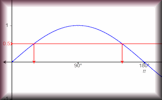Here are some specific activities, investigations or visual aids we have picked out. Click anywhere in the grey area to access the resource.
Here are some exam-style questions on this statement:
- "(a) Write down the exact value of \(\tan 60^o\)." ... more
- "Solve for x where \( -\pi \le x \le \pi \)." ... more
- "(a) Show that \(2x+15+\dfrac{40}{x-3}= \dfrac{2x^2+9x-5}{x-3}, \quad x \in \mathbb{R}, x \neq 3\)" ... more
- "(a) Solve the following trigonometric equation for \(–360° \lt x \lt 360°\):" ... more
- "The cosine of acute angle \( \alpha \) is \( \frac{1}{ \sqrt 5} \)" ... more
Here are some Advanced Starters on this statement:
- Angle Thinking
Find the range of possible angles, x, for which tan x > cos x > sin x more - Exponential Trigonometry
Find, in degrees, all eight of the solutions to the given exponential, trigonometric equation more - Tansum
Find the sum of the tangents of angles on a straight line. more
Click on a topic below for suggested lesson Starters, resources and activities from Transum.
Furthermore
Solving trigonometric equations within a finite interval involves finding all the angles that satisfy the equation within a given range. This can be approached graphically, by plotting the functions and identifying the points of intersection, or analytically, by manipulating the equation using trigonometric identities and inverse functions. When trigonometric equations reduce to a quadratic form in \(\sin x\), \(\cos x\), or \(\tan x\), we can solve them using algebraic techniques similar to those used for quadratic equations.
Key Formulae:
$$\sin^2 x + \cos^2 x = 1$$
$$1 + \tan^2 x = \sec^2 x$$
$$\sin(2x) = 2\sin x \cos x$$
$$\cos(2x) = \cos^2 x - \sin^2 x = 2\cos^2 x - 1 = 1 - 2\sin^2 x$$
Example:
To solve the equation \(2\sin^2 x - \sin x - 1 = 0\) for \(0 \leq x \leq 2\pi\):
Let \(u = \sin x\). The equation becomes \(2u^2 - u - 1 = 0\).
Solving this quadratic equation, we find \(u = -\frac{1}{2}\) or \(u = 1\).
Returning to \(x\), we have \(\sin x = -\frac{1}{2}\) or \(\sin x = 1\).
This yields the solutions \(x = \frac{7\pi}{6}, \frac{11\pi}{6}\) or \(x = \frac{\pi}{2}\) within the given interval.
This video on Solving Trig Functions and Equations is from Revision Village and is aimed at students taking the IB Maths AA SL/HL course.
How do you teach this topic? Do you have any tips or suggestions for other teachers? It is always useful to receive feedback and helps make these free resources even more useful for Maths teachers anywhere in the world. Click here to enter your comments.


